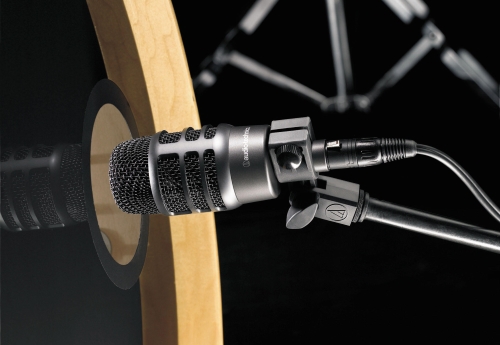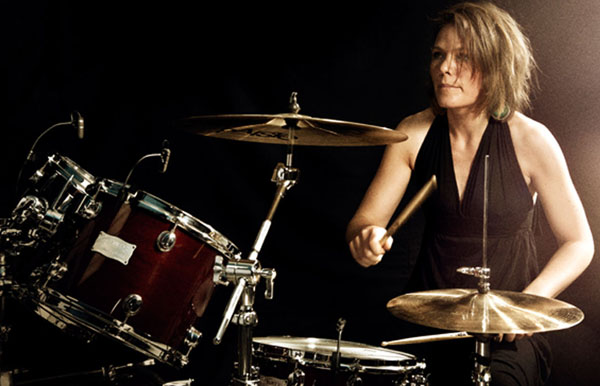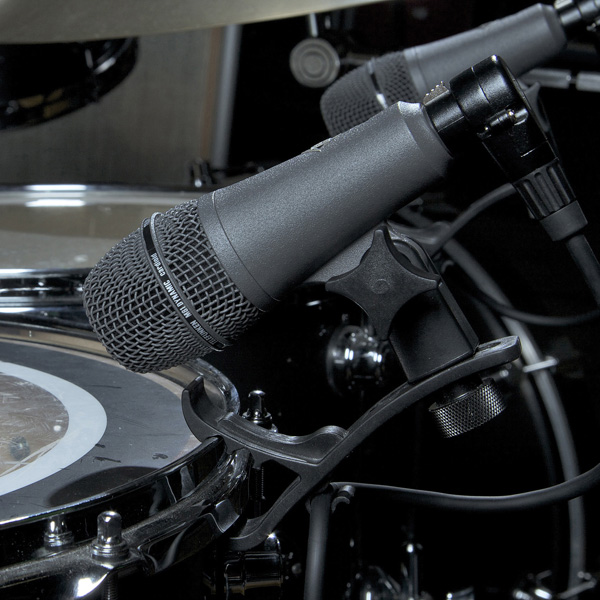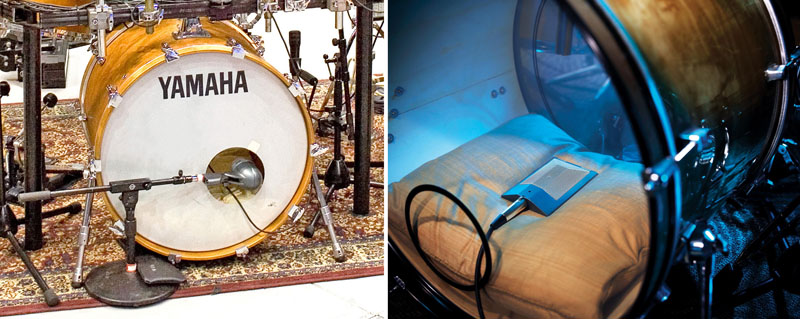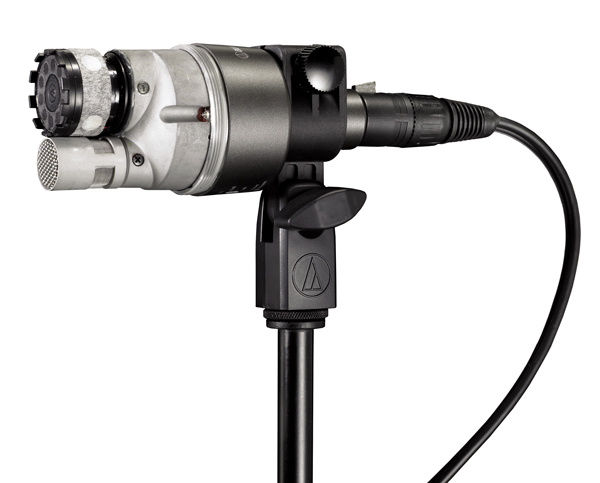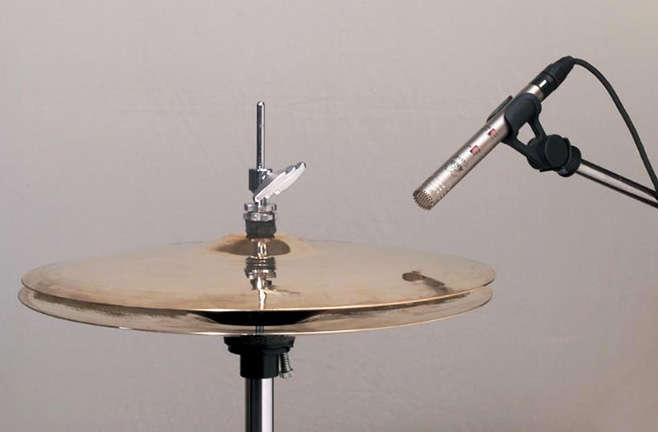The drum sound is the heart of any band mix: kick drum keeps the pulse going, while the snare drives the rhythm and the overall beat gives each song its groove.
Dynamic microphones are used for close miking drums because they’re sturdy, handle high SPL, provide off-axis rejection and often have a presence boost around 4 kHz that emphasizes attack.
At the same time, digital consoles have changed the live sound workflow. Their instant recall forces drum sound check to fit into whatever time is allowed, sometimes no more than a quick line check.
Much attention is paid to the kick drum’s sound because it’s the foundation of many music genres. A common goal is a solid punch in the lows combined with a driving click in the mid-range. These often translate to a boost at 100 Hz or lower and another boost at 1,000 Hz or higher. In order to keep the kick drum from dominating the mix by sounding boomy and boxy, midrange EQ cuts around 200 Hz and 500 Hz can help prevent fundamentals of other mix elements from being overpowered.
Snare drums often exhibit annoying ringing overtones sometimes considered authentic or even classic. Boosting and sweeping a narrow-band EQ to identify an annoying frequency and then cutting only that frequency is called “search and destroy.” The same process can be used for other inputs with annoying overtones and so works well for toms.
Plenty Of Alternatives
Years ago there were few live sound mics to choose from, and the Shure SM58 and SM57, along with earlier Unidyne models, dominated mic box inventory. If it wasn’t a vocal, an SM57 was used, though it and the SM58 sound similar. A generation learned to “tune” the PA by repeating the mantra “check, one-two” into an 58.
Both employ the same capsule and have a reputation for sounding pretty good on almost everything, specifically for their “presence boost” (also called “midrange honk.”) The 57’s flat grille allows positioning closer to sound sources where proximity effect provides a little extra 100 Hz, and the minimal grille contributes to a relative boost above 5 kHz. It can also be damaged when struck hard by a drumstick.
Early on, enterprising roadies discovered the 57’s performance for kick drum could be improved by removing its internal transformer, extending its frequency range, especially in the lows, while reducing midrange honk and improving transient response. This came at the cost of 10 dB of output – not usually a problem for kick drum.
However, the 57 is no longer used as much on snare drum, where its honk and bite are iconic. Today there’s a wide range of alternate choices with a full, clear, modern sound. And a variety of dynamic and condenser models have supplanted its use on toms, with smaller models better suited to being mounted on the rims. Many dynamic mics for toms have similar sensitivity and response, and are somewhat interchangeable.
Condensers usually afford greater sensitivity than dynamics, and provide a more open, detailed sound because of their flatter, extended frequency response and accuracy of transient peaks. However they pick up more of nearby sound sources, so they’re used for overhead or area mics for drums and percussion.
When close-miking hi-hats, under-snare or ride cymbal, a tighter pattern, better placement and attenuation are usually preferred. Checking pattern, pad and high-pass switches becomes second nature with rental condensers, and the use of dynamics for one or more of these applications are sometimes preferred.
What’d You Bring?
When artist engineers don’t bring their own mics, the venue or a local sound vendor provides them. But engineers usually prefer carrying their own because it delivers the highest level of consistency while providing complete freedom of choice for every input, allowing them to carry their best choice for each chore.
When touring with a consistent drum kit, its mics are a relatively minor accessory; however, standardized choices guarantee that they can be provided at every gig without substitution, which is why they appear so often on input lists and technical contract riders.
Commonly provided vendor and/or house drum mic inventory includes Shure BETA 91A and BETA 52A or Audix D6 for kick drum, SM57 for snare, Sennheiser e 604 or Shure BETA 98A for toms, and AKG C 451 or Shure SM81 pencil condensers for cymbals, with AKG C 414 or Shure KSM32 being popular overheads.
Familiar choices help us quickly make adjustments, providing predictable results that are easily duplicated on different consoles. Locally provided mics also allow a band’s crew to walk away from the stage after a show without collecting them.
No matter how much a band tours, eventually there are festival, TV or promotional appearances where all equipment and backline must be locally sourced. Using standard choices for most of or even an entire input list eases the transition from tour to “one-off,” provided the sensitivity and response of the mics matches the ones used in the digital console’s file.
When using rented drums, “house” mics are often good enough, yet a hybrid approach, where the band’s engineer specifies standard selections but brings one or two special artist-supplied mics for “money” channels, provides the best of both worlds. The special mics are quickly struck at the end of each show and easily carried on the airplane in a backpack.
Special duty mics always have great sound as a primary goal, but the further aim for modern kick drum mics is little or no EQ. Classics like the Sennheiser MD 421, Electro-Voice RE20, AKG D 12 E and beyerdynamic M 88 are all outstanding mics, but still must be contoured with channel EQ for kick drum.
The AKG D112 was the first mic tailored for kick drum with a contoured frequency response that requires minimal EQ. The AKG D 12VR, Audix D6, EV RE320, Sennheiser e 902 and Shure BETA 52 all provide pronounced lows, scooped low-mids and enhanced high-midrange, allowing it to sound good right out of the gate.
The kick drum’s sound benefits from attention to how its mic is positioned. Other than jazz kits, a 4- to 6-inch hole in the front head to allow mic access is a modern standard.
A few mics sound good in the middle of this hole or just outside, but many sound better inside the drum than in front of it, due to the improved beater attack and isolation from other drums, with small changes in mic position and even its angle causing the sound to vary widely. The care required in positioning kick drum mics, and the wide variety of models to choose from, ensures that engineers often bring their own.
A second kick mic that’s frequently used is the Shure BETA 91, a boundary condenser first adopted in casino showrooms to provide attack and fullness without sounding boomy to make drums sound better to older audiences. It was quickly adopted as a second kick drum input to supplement the usual dynamics and remains widely popular.
Timing Is Everything
Another old school drum roadie trick is to make the distance from the snare drum to each overhead mic the same, using the length of two drumsticks end-to-end to measure it, which ensures the drum kit’s loudest sound arrives in both overheads at the same time.
Today’s digital consoles allow engineers to delay the snare mic to eliminate the destructive comb filtering produced by combining it in the mix with its arrival a couple milliseconds later in the overhead mics. This method is easily extended to rack and floor toms.
Aligning dual kick drum mics has been around since the early days of Pro Tools, delaying the inside mic to the outside mic. The distance between the two mics, often about a foot, is relatively small compared to their 10-foot wavelength at low frequencies. At higher frequencies, the slight difference in arrival time can cloud their combined sound above 1 kHz.
With the widespread use of digital consoles, adding a millisecond of delay to the inside mic can clean up the highs and improve the kick drum’s attack. Alternatively, Audio-Technica’s AT250DE provides the best of both worlds with a dual-element capsule that incorporates both dynamic and electret transducers that are automatically time-aligned.
In The Library
Touring artists usually travel with a digital console, and their true value is in their files; not just previous show settings, but also their libraries, a collection of presets that can be called up with the click of a cursor, saving the time it takes to adjust the parametric EQ.
Yamaha’s earliest digital consoles provided an EQ library with 40 preset EQ programs and another 40 user EQ memories, while today’s QL and CL Series consoles provide 159 user EQ memories. In addition, EQ libraries are a standard feature on most digital desks.
DiGiCo SD consoles have a preset library that saves the entire channel strip that when recalled can be scoped for just EQ, dynamics and gain. Meanwhile, multi-channel presets allow an entire drum kit’s settings to be saved.
Engineers who carefully archive previous shows already have the information they need to build a set of mic-specific channel EQ presets. Opening an old file and using the settings from individual channels to store presets for specific instrument and mic combinations is a quick way to start building a library.
Since we repeatedly equalize the same models of drum mics in a similar fashion, saving EQ presets allows us to quickly pre-adjust an entire drum kit EQ by loading a previously tweaked preset for each drum mic into the right channel. Presets called “KICK52” or “SNARE57” have meaningful names that describe their use, allowing them to be correctly identified and quickly applied.
Library presets aren’t meant to replace actually listening to drums during sound check; rather they allow a file to quickly be built when time is at a premium and show time is looming.


